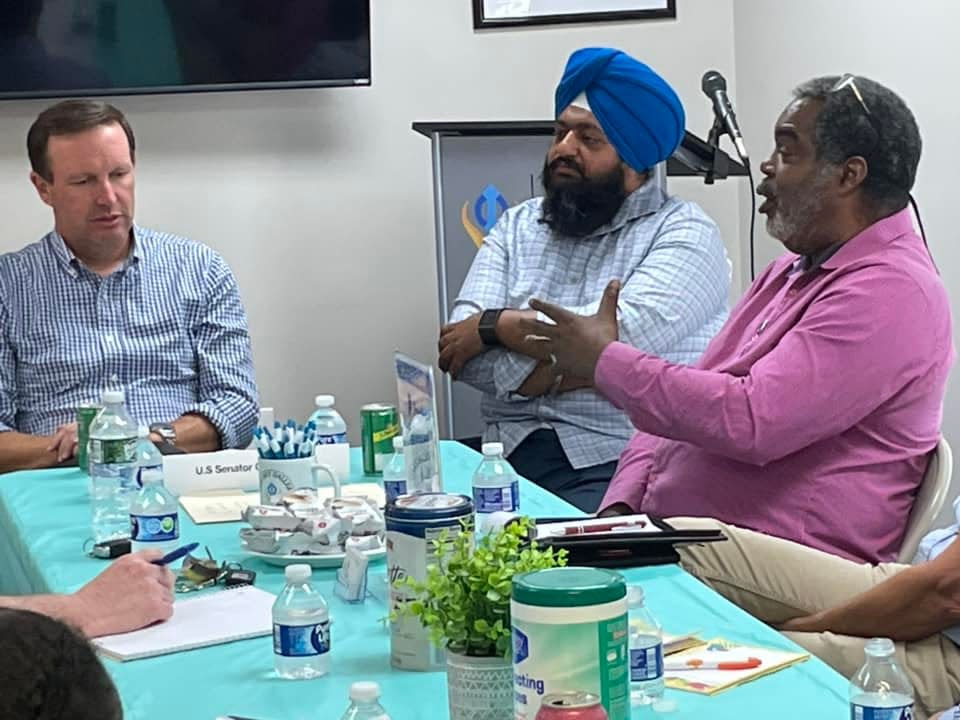Supporting the faith community may be a way to address loneliness
Members of the Norwich Interfaith Association and other Norwich community leaders met with U.S. Sen. Chris Murphy at the Sikh Art Gallery Tuesday, concerned about loneliness among adults and the social impact from the decline of churches and church attendance.
In June, Gallup Polls said church attendance was still bellow pre-pandemic attendance. During the four years before pandemic, an average of 34% of Americans attended services at a church, mosque or temple weekly. Since 2020, it’s dropped to only 30%, with a 31% average for a survey conducted in May.
At its peak, close to half of Americans went to places of worship weekly in the 1950s and 1960s, Gallup Poll data states.

Reasons for the decline in attendance
Part of the concern from religious organizations, locally and more broadly, is self-preservation. Sikh Art Gallery Creative Director Swaranjit Singh Khalsa said some people in his community aren’t getting initiated, in part because they want to blend in with the rest of society. There needs to be more positivity toward faith, he said.
“I feel bad, because (faith) helps them be a better human,” he said.
As working on the weekend becomes more common, people are missing worship times for work. There’s a woman who has been wanting to worship at St. Mary’s Church, but isn’t able to make it due to her job at a restaurant at Mohegan Sun, said Father Robert Washabaugh, priest of St. Mary’s and St. Peter and Paul Catholic churches in Norwich.
“Even if we try creative times, people may say they’re too busy to go to church,” he said.
Churches and religious buildings face possibly unsustainable maintenance costs
There’s also the practical side of maintaining a church building. If it’s only the same 30 churchgoers contributing, there’s going to be a point where fewer and fewer people are able to support maintenance, Rev. Eric Heinrich of St. Mark’s Evangelical Lutheran Church said.
“If we were to close our doors in the future, because the 30 people who worship regularly can’t sustain it, it’s going to be felt by the groups that use it,” he said.
While St. Mary’s and Greeneville Congregational Church recently got grants for repairing their buildings, it’s generally hard for churches to get state grants because of the religious affiliation, Heinrich said.
There’s been a discomfort around public funds being used for religious institutions, but as churches, social clubs, and other traditional social spaces go away, there’s a crisis for these types of spaces, Murphy said.
More: Thermos Factory campus to Greeneville Congregational Church: Norwich gets state money
More: Norwich City Councilor reflects on major anti-Sikh hate anniversary
Outside groups often use religious buildings
Outside of religious organizations, many community groups use religious spaces as meeting places. This can range from youth activities to meetings for addiction recovery programs.
“If they had their own space, they might have the eligibility to fix the roof on their space,” he said.
For the latter, many addiction recovery programs started from meetings in church basements. While there are many drug recovery programs now, both religious and secular, the need to have places to meet, including churches, is important. While zoom meetings tried to fill a void during the pandemic, it’s not comparable to meeting face to face, and going remote brings a greater relapse risk, SCADD Chief Strategy Officer Jennifer Chadukiewicz said.
“There’s not enough meetings for the number of people we’re pushing through detox and treatment,” she said.
In-person Narcotics Anonymous meetings dropped from over 400 around the state before the pandemic, to only 110 now, Chadukiewicz said.
Epidemic of loneliness and isolation
The need to find ways to preserve church spaces for worship and for community use plays into a larger conversation about loneliness after the pandemic. In a U.S. Surgeon General’s report from this year, called “Our Epidemic of Loneliness and Isolation,” it states that in 1990, 27% of American adults had three or fewer close friends. That figure is now 49%, as of 2021.
Murphy organized the Tuesday meeting to help promote legislation he introduced. The National Strategy for Social Communication Act would support CDC research into loneliness and isolation, while creating the Office of Social Connection Policy within the White House to issue social connection guidelines and create strategies to improve quality of life in communities, a press release from his office states.
However, there are people for who church doesn’t feel like a safe space, even though some churches are open and affirming. Kia Baird, outreach and impact coordinator for the Southeastern Connecticut Cultural Coalition, said she offered the LGBTQ+ organization OutCT, a group she was once the president of, office space in the church she attends, but they turned it down because some in the group would be uncomfortable in that setting.
“There’s a marketing piece,” she said. “Getting the word out that the spaces that are safe, are welcoming.”
While churches look to get more funding and support, they also need to be seen as working together, rather than competing against each other for money and time, Rev. Paul Doyle of Park Congregational Church, and part of Reliance Health’s Gay Straight Alliance.
“We need to be louder than the polarization,” he said.
This article originally appeared on The Bulletin: Norwich Interfaith met with Sen. Murphy on social role of faith community

